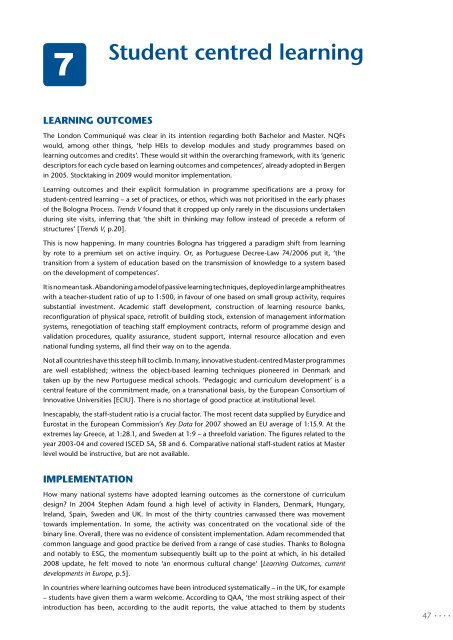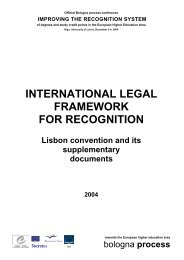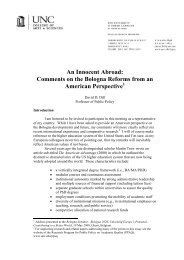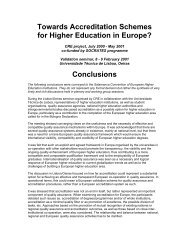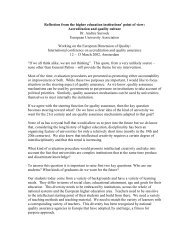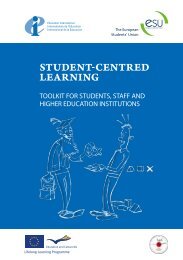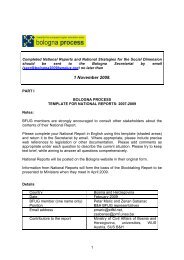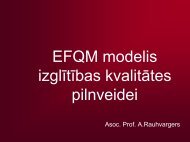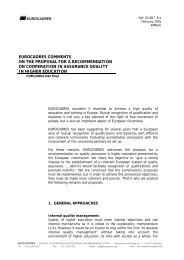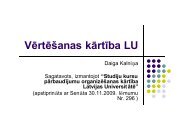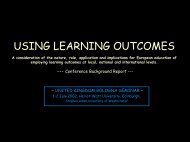EUA Survey Of Master Degrees In Europe - European University ...
EUA Survey Of Master Degrees In Europe - European University ...
EUA Survey Of Master Degrees In Europe - European University ...
Create successful ePaper yourself
Turn your PDF publications into a flip-book with our unique Google optimized e-Paper software.
7Student centred learningLearning outcomesThe London Communiqué was clear in its intention regarding both Bachelor and <strong>Master</strong>. NQFswould, among other things, ‘help HEIs to develop modules and study programmes based onlearning outcomes and credits’. These would sit within the overarching framework, with its ‘genericdescriptors for each cycle based on learning outcomes and competences’, already adopted in Bergenin 2005. Stocktaking in 2009 would monitor implementation.Learning outcomes and their explicit formulation in programme specifications are a proxy forstudent-centred learning – a set of practices, or ethos, which was not prioritised in the early phasesof the Bologna Process. Trends V found that it cropped up only rarely in the discussions undertakenduring site visits, inferring that ‘the shift in thinking may follow instead of precede a reform ofstructures’ [Trends V, p.20].This is now happening. <strong>In</strong> many countries Bologna has triggered a paradigm shift from learningby rote to a premium set on active inquiry. Or, as Portuguese Decree-Law 74/2006 put it, ‘thetransition from a system of education based on the transmission of knowledge to a system basedon the development of competences’.It is no mean task. Abandoning a model of passive learning techniques, deployed in large amphitheatreswith a teacher-student ratio of up to 1:500, in favour of one based on small group activity, requiressubstantial investment. Academic staff development, construction of learning resource banks,reconfiguration of physical space, retrofit of building stock, extension of management informationsystems, renegotiation of teaching staff employment contracts, reform of programme design andvalidation procedures, quality assurance, student support, internal resource allocation and evennational funding systems, all find their way on to the agenda.Not all countries have this steep hill to climb. <strong>In</strong> many, innovative student-centred <strong>Master</strong> programmesare well established; witness the object-based learning techniques pioneered in Denmark andtaken up by the new Portuguese medical schools. ‘Pedagogic and curriculum development’ is acentral feature of the commitment made, on a transnational basis, by the <strong>Europe</strong>an Consortium of<strong>In</strong>novative Universities [ECIU]. There is no shortage of good practice at institutional level.<strong>In</strong>escapably, the staff-student ratio is a crucial factor. The most recent data supplied by Eurydice andEurostat in the <strong>Europe</strong>an Commission’s Key Data for 2007 showed an EU average of 1:15.9. At theextremes lay Greece, at 1:28.1, and Sweden at 1:9 – a threefold variation. The figures related to theyear 2003-04 and covered ISCED 5A, 5B and 6. Comparative national staff-student ratios at <strong>Master</strong>level would be instructive, but are not available.ImplementationHow many national systems have adopted learning outcomes as the cornerstone of curriculumdesign? <strong>In</strong> 2004 Stephen Adam found a high level of activity in Flanders, Denmark, Hungary,Ireland, Spain, Sweden and UK. <strong>In</strong> most of the thirty countries canvassed there was movementtowards implementation. <strong>In</strong> some, the activity was concentrated on the vocational side of thebinary line. Overall, there was no evidence of consistent implementation. Adam recommended thatcommon language and good practice be derived from a range of case studies. Thanks to Bolognaand notably to ESG, the momentum subsequently built up to the point at which, in his detailed2008 update, he felt moved to note ‘an enormous cultural change’ [Learning Outcomes, currentdevelopments in <strong>Europe</strong>, p.5].<strong>In</strong> countries where learning outcomes have been introduced systematically – in the UK, for example– students have given them a warm welcome. According to QAA, ‘the most striking aspect of theirintroduction has been, according to the audit reports, the value attached to them by students47


